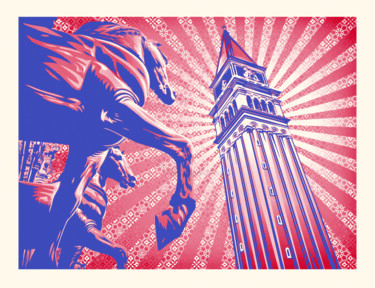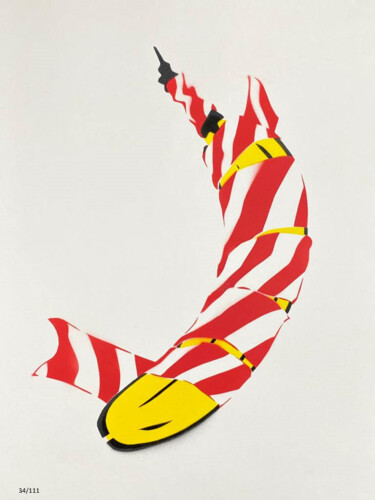 Albrecht Dürer, Coronation of the Virgin, 1500-1511. Woodcut from the series "Life of the Virgin."
Albrecht Dürer, Coronation of the Virgin, 1500-1511. Woodcut from the series "Life of the Virgin."
Everyone knows this story
Engraving, an artistic technique in intaglio or relief, has among its earliest documented examples those dating back to the 7th century BC, found in Egypt and China, and later also in Greece. The woodcut method arrived in Europe in the 14th century, first spreading in the realm of playing cards, and later in the production of religious images and books. The master of the woodcut genre par excellence is Albrecht Dürer. The tradition of engraving, on the other hand, comes later, spreading from the example of its most accredited inventor: Maso Finiguerra. This method of engraving on an etching plate was highly successful between the 16th and 17th centuries, although during this latter period, etching, an indirect technique, was similarly popular, reaching a high level of execution and artistic refinement, thanks to the contribution of Rembrandt. The 19th century saw the rise of lithography, whose greater speed in executing subjects, as well as its technical and expressive potential, made it the new engraving system par excellence, experimented with by great masters such as Toulouse-Lautrec, Pablo Picasso, and Paul Klee. Finally, it is obligatory to add further notions regarding techniques that have so far been overlooked, namely: drypoint, mezzotint, soft-ground etching, and aquatint.
Drypoint: Initially, it was used to refine the different states of engraving done with the burin, and only later, from the 15th century onwards, was it used autonomously.
Mezzotint: Originating in seventeenth-century Germany, it is the only technique that allows for chiaroscuro passages, as the surface of the plate is prepared in black, which, when scraped, is capable of offering all the intermediate values.
Soft-ground etching: It is a process similar to etching, but with which more blurred and irregular marks are produced, reminiscent of those obtained with charcoal or pencil drawings.
Aquatint: Dating back to the 18th century, due to its versatility, it was used, like mezzotint, mainly as a means to imitate chiaroscuro values.
 Marcantonio Raimondi, Massacre of the Innocents after Raphael, circa 1511. Engraving.
Marcantonio Raimondi, Massacre of the Innocents after Raphael, circa 1511. Engraving.
The reproductive engraving
What has just been said can be found written in various ways on numerous sources, which often overlook a parallel narrative, perhaps less known but decidedly intriguing, as it connects the lives of some of the most renowned engravers with those of extremely popular painters. How so? In the first half of the sixteenth century, there were highly celebrated artists, but, given the difficulties of traveling to admire their works in person, they were "replaced" by reproductive engravings. By this term, we mean prints aimed at reproducing works of art on paper, copies of which were purchased for study by other artists, as well as for a purer and more economical desire for possession. Who had the brilliant idea to start this business? Marcantonio Raimondi! He was, indeed, an Italian engraver born around 1470, known for being a key figure in the rise of reproductive printing, a genre to which he dedicated most of his career. During this time span, Marcantonio directly dealt, for various reasons that we will reveal later, with Albrecht Dürer, Raphael, and Giulio Romano! Let's begin with the master from Nuremberg...
 Albrecht Dürer, The Carrying of the Cross, 1497-1510. Woodcut from the series "The Great Passion."
Albrecht Dürer, The Carrying of the Cross, 1497-1510. Woodcut from the series "The Great Passion."
Marcantonio Raimondi and Albrecht Dürer
Before recounting the story that brings together the two personalities in question, I need to make some fundamental premises: Dürer's prints are original works, conceived and executed by the same person, while Marcantonio's activity consists of reproducing a graphic or pictorial model created by another artist. The German artist emphasized this difference by affixing his monogram to his woodcuts, intended precisely to make his authorship clear and explicit. It is precisely on this last point that Vasari's account focuses, aiming to narrate how Marcantonio, upon arriving in Venice and discovering the fine hand of the German artist, with the intention of spreading his excellent styles also in Italy, copied some of the plates of the Nuremberg master, on which he also added the aforementioned monogram "AD." The Italian thus began to sell the prints passing them off as originals, a fact that reached Dürer's ears, who traveled from Flanders to Venice, where, at the Signoria, he sued Marcantonio, also requesting the seizure of the matrices and the exclusion from the trade of the prints in question. Nevertheless, the German obtained nothing more than Marcantonio agreeing not to mention or sign the name of the aforementioned Albert anymore. Let's now move on to Raphael and Giulio Romano!
 Marcantonio Raimondi, Judgment of Paris after Raphael, circa 1514-18. Engraving.
Marcantonio Raimondi, Judgment of Paris after Raphael, circa 1514-18. Engraving.
Marcantonio Raimondi, Raphael, and Giulio Romano
Raphael also wanted to get in touch with Raimondi, but with different intentions, guided by a more mature awareness. Despite never dedicating himself to engraving, the Urbinate held it in high regard, nurturing the prolific intuition that it could become a tool for promoting his art, which could more easily spread throughout Europe. So, he decided to make these intentions concrete, contacting Marcantonio, whose work he had become acquainted with through the aforementioned copies by Dürer. On this occasion, the painter asked the engraver to reproduce in series and with high editions a large quantity of his paintings and drawings, including those preparatory for his magnificent tapestries. Consequently, Raimondi was the first engraver of Raphael's works, whose work represents tangible evidence that through the circulation of prints, it is possible to multiply the dissemination of an idea, as well as its enjoyment among a much wider audience than that of mere scholars. How did Marcantonio organize this work? He established a workshop organized for engraved production and the publishing market, aimed at creating engravings based on Raphael's designs specifically intended for this purpose. After Raphael's death, Raimondi continued to work in the workshop collaborating with Giulio Romano, the author of the sixteen engravings of the erotic book "I Modi." This Renaissance work, representing the first Italian case of scenes of explicit sex intended for commerce, was created in its original version by Marcantonio, who took sensual paintings that Giulio had made for Federico II Gonzaga as a model. However, the prints, published in Rome in 1524, were burned by Pope Clement VII, while Raimondi was imprisoned. The second edition in 1527 led to similar events and censorship. It is time to show an example of Raimondi's work, synthesized by the engraving of "The Judgment of Paris" after Raphael.
 A detail of a river god from Raimondi's engraving.
A detail of a river god from Raimondi's engraving.
Analysis of the work: Raimondi's "Judgment of Paris" after Raphael
The artwork known as "The Judgment of Paris," originally created by the Italian painter Raphael, exists now only through engravings by Marcantonio Raimondi, as the original drawing has been lost. This theme ranks among the most frequently depicted in art history, spanning across various periods including the Renaissance, Baroque, and even into the twentieth century. The composition, partly inspired by a Roman sarcophagus of the same subject, portrays numerous groups of figures immersed in a picturesque landscape teeming with vegetation, with the central group featuring Paris and the three goddesses standing out. Paris is depicted offering the apple of discord to Venus, who is being crowned by a winged Victory, while Juno, identifiable by the peacock at her feet, seems to be threatening the Trojan prince. Minerva, on the other hand, is shown tightening the garment she has removed, having also discarded her helmet and shield bearing the head of Medusa. To the right of the support, a group of river deities is depicted, one of whom engages directly with the viewer, while another gazes upward, catching a glimpse of Jupiter among the clouds, seated on his throne. Raimondi's engravings have enabled the knowledge, as well as the dissemination and reinterpretation, of the composition in question, a work whose impact on art history remains profound. In the river deities, we can recognize some of the characters that inspired the French painter Édouard Manet for his "Luncheon on the Grass." Finally, it is possible to highlight other famous collaborations that, within the historical-artistic narrative, were established between engravers and artists.
 Mantegna, Bacchanal with a Wine Vat, 1475-80. Engraving with burin and drypoint on paper.
Mantegna, Bacchanal with a Wine Vat, 1475-80. Engraving with burin and drypoint on paper.
Other Famous Collaborations
Andrea Mantegna, not only a painter but also an Italian miniaturist and engraver, is known for his prints rich in scenic impetus, rendered with extremely accurate perspective and plasticity, as seen in Bacchanal with a Wine Vat. The burin and drypoint in question depict a series of characters, such as satyrs, cherubs, and men, who, in the shade of a vine, take part in a bacchanal. In this frenetic scene, Mantegna depicted moments of blissful abandonment to vice, effectively presenting a world dominated by the basest instincts. Throughout this, the artist reformulated the classical model, updating it according to his sensibility and style, ready to stand out against a dark background intended to highlight the light figures like sculptural reliefs. Although the work is one of the most well-known among the approximately ten engravings attributed to Mantegna, its dating is difficult, as it could have been derived from a painting or fresco that has been lost. Furthermore, we do not know why Mantegna created these prints, but we are certain that an adept reproducer of the latter was Zoan Andrea, an Italian engraver who lived between the 15th and 16th centuries. Regarding the painter Giorgione, his follower and engraver Giulio Campagnola drew particular inspiration from his work, as evidenced by their similar treatment of astrological themes, seen in both the "Frieze of the Liberal and Mechanical Arts" (Giorgione) and the "Astrologer" (Campagnola). We conclude this non-exhaustive section of artistic "sodalities" by discussing Agostino Carracci, Veronese, and Tintoretto. Indeed, the first, an Italian painter and engraver, arrived in Venice between 1587 and 1589, where he became, in a sense, the official engraver of Veronese, as well as the celebrated graphic interpreter of one of Tintoretto's most famous works: "The Crucifixion" (1565). The narrative thus concludes where it began: in Venice!


 Olimpia Gaia Martinelli
Olimpia Gaia Martinelli



































